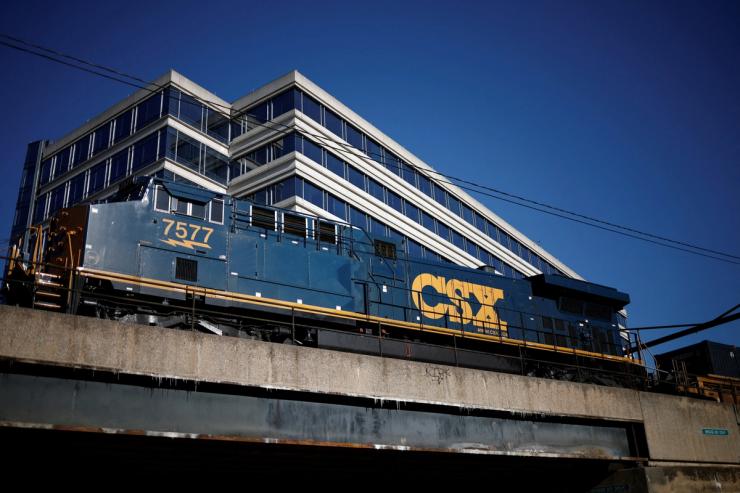The Scoop
The CEO of one of America’s largest railroads was fired last month after his board felt he had mishandled a takeover approach from a rival, people familiar with the matter said, and after months of tension with his directors over his pay.
Joe Hinrichs’ abrupt ouster from CSX followed informal outreach earlier this year from his counterpart at Union Pacific about potentially merging the two railroads, outreach that Hinrichs failed to pursue, the people said. The tepid response sent Union Pacific CEO Jim Vena looking elsewhere, and Union Pacific quickly struck a deal with another railroad, Norfolk Southern.
After that deal was announced in July, CSX directors pressed Hinrichs on how seriously he had engaged and why he hadn’t been more forthcoming with the board, the people said.
One of the people said all conversations with Vena or Union Pacific were shared quickly and transparently with CSX’s board. Union Pacific’s merger filings don’t note explicitly any early-stage conversations with CSX, but noted that Union Pacific executives “from time to time” held “informal conversations with senior executives of other railroad companies,” including about “strategic transactions.”
His firing is the latest sign that the easy times for US CEOs are quickly drawing to a close. Boards appear less willing to tolerate underperformance or personal missteps, leading to a spike in changes at the top of some of the world’s biggest companies.
More than 1,500 CEOs have left their job through September of this year, according to data from Challenger, Gray & Christmas. Nestle’s Laurent Freixe was fired for an undisclosed relationship with a subordinate; Novo Nordisk’s Lars Fruergaard Jørgensen left after the board deemed he’d squandered the company’s lead in billion-dollar weight-loss drugs; GSK and mining giant Barrick swapped out their CEOs after their stocks lagged rivals’.
A spokesperson for CSX declined to comment. Hinrichs told Semafor that he was “proud” of what he and his team had accomplished and declined to answer specific questions about his departure.
In this article:
Know More
Hinrichs’ performance over the last year was similarly lackluster. CSX’s stock price was middle-of-the-pack, but it had lagged on key efficiency metrics. Hinrichs had also clashed with CSX’s board over his compensation, according to the people familiar — which at $14 million in 2024 was significantly smaller than his predecessor’s. He repeatedly sought a pay bump for himself and other members of his senior team, one of the people said.
His insistence on a raise, while CSX shares fell, frustrated directors this spring. Vena broached the idea of potentially acquiring CSX with Hinrichs earlier this year, and later told confidants that he got no indication Hinrichs was open to the idea, the people said. (Other CSX executives were publicly tamping down deal talk at the same time: “We think there’s a lot of untapped value that we can control and drive from a share price perspective,” CSX’s chief commercial officer said in May.)
Union Pacific quickly lasered in on Norfolk Southern, which — wary of being left out of what might be endgame consolidation in US carriers — quickly agreed to negotiate exclusively with Union Pacific. News of the deal shocked CSX’s board, the people said. An $85 billion merger took less than two weeks to firm up, leaving CSX as the smallest US railroad and on the back foot.
A last-minute earnings call hail mary from Hinrichs wasn’t enough to derail Norfolk and Union’s deal, and after BNSF took repeated opportunities to indicate it was uninterested in acquiring CSX, the railroad’s directors had enough. They ousted Hinrichs in favor of a seasoned executive with M&A chops, who out of the gate made it clear that he would be very open to a deal, once he’d turned the railroad around.
Rohan’s view
It’s now or never for late-stage, large-scale M&A, what Goldman Sachs President John Waldron called “endgame consolidation” at Semafor’s World Economy Summit last week. Executives and advisors increasingly feel that big deals which weren’t possible under Biden or even Trump 1.0 are now viable. That means CEOs who wouldn’t normally be thinking about selling a company out from underneath them — out of pride, a belief they can make more money for shareholders, or simply a desire to remain employed — are being faced with uncomfortable offers. Look to Paramount’s pursuit of Warner Brothers for a non-industrial example.
Hinrich’s counterpart at Norfolk Southern had been in the top job for a little more than a year but quickly saw the writing on the wall. Hinrichs either didn’t or felt he could get a better price for his company with more time. Either way, his failure to engage cost him his job and serves as a warning signal for long-tenured chiefs and those fresh to the seat: timing is everything.
Room for Disagreement
The biggest railroaders in the United States, Berkshire’s BNSF, have repeatedly said they don’t think transformative, transcontinental M&A is the right maneuver right now. So have their Canadian peers. And the key-man risk of deals has never been sharper: President Donald Trump blessed the Union Pacific merger earlier this year, but has shown no hesitation to block or leverage transactions he’s unhappy with.
Notable
- Deal volumes and values have now caught up to the cheery vibes that some advisors were feeling earlier this year, before Liberation Day momentarily derailed them.


